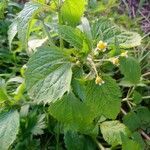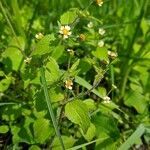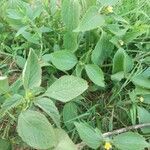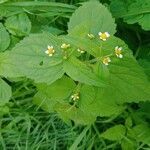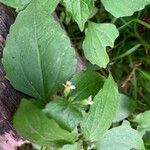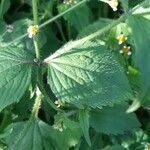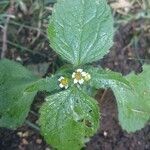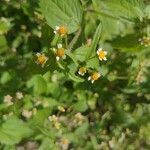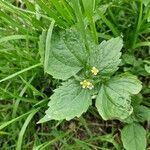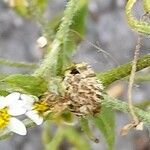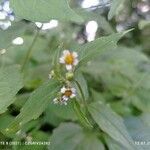Freely branching, somewhat hairy, 2–7 dm, the hairs of the stem generally fairly coarse and spreading; lvs petiolate, with ovate (often broadly so), rather coarsely toothed blade 2.5–7 × 1.5–5 cm; heads mostly rather numerous (in well developed plants) in open, leafy cymes, slender-pedunculate, the peduncles and often also the invols spreading-villous, with gland-tipped hairs; outer invol bracts 1–2, herbaceous, deciduous, the inner 3–4 mm, deciduous with their attached receptacular bracts; rays (3–)5(6), white (pink), strongly 3-toothed, 2–3 mm, nearly as wide; inner receptacular bracts mostly entire; disk 3–6 mm wide; achenes black, hispidulous with appressed or ascending hairs; pappus of the disk of slender, fimbriate scales tapering to a short but definite awn-tip, often shorter than the cor, that of the rays of short but well developed fimbriate scales, about equaling the tube; 2n=32, 48, 64. Native of C. and S. Amer., now a cosmopolitan weed. June–Nov. (G. bicolorata and G. caracasana, with pink rays; G. ciliata)
Plants 8-62 cm. Leaf blade 20-60 × 15-45 mm. Peduncles 5-20 mm; involucres hemispheric to campanulate, 3-6 mm in diam.; phyllaries deciduous; outer paleae deciduous, broadly elliptic to obovate, 2-3 mm, inner deciduous, linear to lanceolate, 2-3 mm, entire or 2-or 3-lobed, lobes to 1/3 total lengths, blunt. Ray florets (4 or)5(-8); corollas usually white, sometimes pink, lamina 0.9-2.5 × 0.9-2 mm. Disk florets 15-35. Ray achenes 1.5-2 mm; pappus of 6-15 fimbriate scales 0.5-1 mm; disk achenes 1.3-1.8 mm; pappus absent or of usually 14-20, rarely 1-5, white, lanceolate to oblanceolate, fimbriate, sometimes aristate, scales 0.2-1.7 mm. Fl. Jul-Oct. 2n = 32, 48, 64.
Plants 8–62 cm. Leaf blades 20–60 × 15–45 mm. Peduncles 5–20 mm. Involucres hemispheric to campanulate, 3–6 mm diam. Phyllaries falling. Paleae: outer falling, broadly elliptic to obovate, 2–3 mm; inner falling, linear to lanceolate, 2–3 mm, entire or 2-or 3-lobed, lobes to 1/3 total lengths, blunt. Ray florets (4–)5(–8); corollas usually white, sometimes pink, laminae 0.9–2.5 × 0.9–2 mm. Disc florets 15–35. Cypselae: rays 1.5–2 mm; discs 1.3–1.8 mm; pappi: rays of 6–15 fimbriate scales 0.5–1 mm; discs 0, or of usually 14–20, rarely 1–5, white, lanceolate to oblanceolate, fimbriate, sometimes aristate, scales 0.2–1.7 mm. 2n = 32 [48, 64].
Annual herb 20–80 cm high; branches scabridulous.. Leaves petiolate, ovate, 2.5–7 cm long, 1–5 cm wide, base cuneate, margins crenate-serrate, apex acute, scabridulous to glabrous on both surfaces; 3-veined from base; petiole to 35 mm long.. Capitula in few-headed cymes, terminal or in upper axils; involucre 2.6–3.5 mm long; phyllaries pilose to glabrous; paleae ciliolate.. Ray florets white, 4–5, the ray 1–1.6 mm long; disc florets greenish, 1.2–1.7 mm long, pubescent.. Achenes black, 1.5–1.7 mm long, pilose; pappus of ± 18 narrow scales, each with apical awn to 1.2 mm long.
Annual herb 20-80 cm high; branches scabridulous. Leaves petiolate, ovate, 2.5-7 cm long, 1-5 cm wide, base cuneate, margins crenate-serrate, apex acute, scabridulous to glabrous on both surfaces; 3-veined from base; petiole to 35 mm long. Capitula in few-headed cymes, terminal or in upper axils; involucre 2.6-3.5 mm long; phyllaries pilose to glabrous; paleae ciliolate. Ray florets white, 4-5, the ray 1-1.6 mm long; disc florets greenish, 1.2-1.7 mm long, pubescent. Achenes black, 1.5-1.7 mm long, pilose; pappus of ±18 narrow scales, each with apical awn to 1.2 mm long.
Annual herb, up to 500 mm tall. Peduncle hairs long and spreading with some long glandular hairs. Receptacular paleae commonly not trifid. Pappus scales with terminal awn. Flowers with white rays, disc white or yellow; January to February and May to August.
An erect herb. It grows to about 75 cm high. The leaves are wedge shaped with teeth along the edge. They are hairy on both surfaces. They taper to the base. The flower heads are yellow. The fruit is dry and one seeded.
